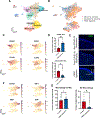Persistent post-COVID-19 smell loss is associated with immune cell infiltration and altered gene expression in olfactory epithelium
- PMID: 36542694
- PMCID: PMC10317309
- DOI: 10.1126/scitranslmed.add0484
Persistent post-COVID-19 smell loss is associated with immune cell infiltration and altered gene expression in olfactory epithelium
Abstract
SARS-CoV-2 causes profound changes in the sense of smell, including total smell loss. Although these alterations are often transient, many patients with COVID-19 exhibit olfactory dysfunction that lasts months to years. Although animal and human autopsy studies have suggested mechanisms driving acute anosmia, it remains unclear how SARS-CoV-2 causes persistent smell loss in a subset of patients. To address this question, we analyzed olfactory epithelial samples collected from 24 biopsies, including from nine patients with objectively quantified long-term smell loss after COVID-19. This biopsy-based approach revealed a diffuse infiltrate of T cells expressing interferon-γ and a shift in myeloid cell population composition, including enrichment of CD207+ dendritic cells and depletion of anti-inflammatory M2 macrophages. Despite the absence of detectable SARS-CoV-2 RNA or protein, gene expression in the barrier supporting cells of the olfactory epithelium, termed sustentacular cells, appeared to reflect a response to ongoing inflammatory signaling, which was accompanied by a reduction in the number of olfactory sensory neurons relative to olfactory epithelial sustentacular cells. These findings indicate that T cell-mediated inflammation persists in the olfactory epithelium long after SARS-CoV-2 has been eliminated from the tissue, suggesting a mechanism for long-term post-COVID-19 smell loss.
Conflict of interest statement
Figures





Update of
-
Persistent post-COVID-19 smell loss is associated with inflammatory infiltration and altered olfactory epithelial gene expression.bioRxiv [Preprint]. 2022 Apr 18:2022.04.17.488474. doi: 10.1101/2022.04.17.488474. bioRxiv. 2022. Update in: Sci Transl Med. 2022 Dec 21;14(676):eadd0484. doi: 10.1126/scitranslmed.add0484. PMID: 35478953 Free PMC article. Updated. Preprint.
References
-
- Boscolo-Rizzo P, Hummel T, Hopkins C, Dibattista M, Menini A, Spinato G, Fabbris C, Emanuelli E, D’Alessandro A, Marzolino R, Zanelli E, Cancellieri E, Cargnelutti K, Fadda S, Borsetto D, Vaira LA, Gardenal N, Polesel J, Tirelli G, High prevalence of long-term olfactory, gustatory, and chemesthesis dysfunction in post-COVID-19 patients: a matched case-control study with one-year follow-up using a comprehensive psychophysical evaluation. Rhinology 59, 517–527 (2021). - PubMed
-
- Boscolo-Rizzo P, Menegaldo A, Fabbris C, Spinato G, Borsetto D, Vaira LA, Calvanese L, Pettorelli A, Sonego M, Frezza D, Bertolin A, Cestaro W, Rigoli R, D’Alessandro A, Tirelli G, Da Mosto MC, Menini A, Polesel J, Hopkins C, Six-Month Psychophysical Evaluation of Olfactory Dysfunction in Patients with COVID-19. Chem Senses 46, (2021). - PMC - PubMed
Publication types
MeSH terms
Substances
Grants and funding
LinkOut - more resources
Full Text Sources
Medical
Molecular Biology Databases
Miscellaneous

